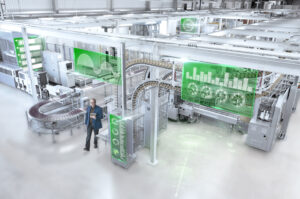As industrial companies across many verticals embark on digital transformation initiatives aimed at improving business processes and outcomes, they are finding edge computing is crucial to the effort. But the operational technology (OT) groups responsible for industrial systems need help in deploying the IT systems digital transformation requires, and that IT/OT convergence is presenting opportunities for industrial system integrators and IT solution providers alike.
Defining the industrial edge
To understand the opportunity, let’s first explain exactly what we mean by industrial edge.
To capture the benefits of industrial automation, companies cannot rely on cloud-based solutions alone because of the speed and resiliency that applications such as artificial intelligence, machine learning, and other Industry 4.0 technologies demand. Instead, they need local IT infrastructure to provide processing and storage power. That infrastructure can come in a variety of enclosures and spaces, but when it’s located in industrial environments such as a manufacturing plant or distribution center, it’s known as industrial edge computing.

“The industrial edge is one of the fastest-growing segments of industrial automation and a key driver that is influencing digital transformation,” according to Craig Resnick, Vice President, ARC Advisory Group. He notes industrial edge computing is crucial to helping manufacturers properly measure asset performance, rapidly identify problem areas, and make changes in real-time to improve their operations and deliver the shortest possible ROI.
He’s right. I recently participated in a virtual panel discussion with a couple of experts in this area, including Tripp Partain, CTO for Edge and IoT systems at Hewlett Packard Enterprise (HPE). He shared a story of a manufacturer that replaced its manual quality assurance (QA) process with an automated one that used a series of cameras on a robotic gantry to perform roughly 90 QA checks on each product. At first, the company used a cloud-based compute resource to analyze the video but found the turnaround time was 21 seconds. The company actually had to slow down the manufacturing line so the automated process could catch up.
After switching to an edge computing solution right next to the line, response time went down to 1 second. So, the manufacturer gained 93 seconds per product on the QA time — multiplied by 45,000 products per month that comes to more than 1,000 hours. And the automated process delivered a 25-percent improvement in QA outcomes, improving overall product quality. Now that’s a rapid ROI.
Delivering on the industrial edge vision
Yet, industrial companies face a dilemma in terms of how best to implement industrial edge computing solutions to drive their digital transformation efforts.
In an industrial setting, be it a manufacturing plant or waste water treatment facility, the edge computing systems are being used to drive machines and processes classified as OT. But OT staff generally don’t have the experience required to install and operate the servers, storage, software, and networking equipment that are fundamental to edge computing. Such systems are traditionally the purview of IT, which means edge computing requires close cooperation between IT and OT groups that traditionally operated in their respective silos.
Industrial system integrators and IT solution providers can help companies bridge that IT/OT gap, while also providing expertise in designing, deploying, and managing IT infrastructure that enables IIoT applications. They can also help industrial customers deal with the myriad of suppliers involved in any edge computing solution.
Jarrett Campbell, Director of Strategic Marketing at AVEVA, was another one of the virtual panel participants. He pointed out that while AVEVA makes software-based process control systems, the company relies on systems integrators to actually make it work effectively for specific use cases.
“We cannot imagine all of the specific scenarios, details, and workflows that a manufacturer or water utility or oil and gas provider need in order to realize value from their operations,” he said. “So systems integrators play an incredibly important role in that last mile effort of going from a software product to a fully bespoke, customized software solution that meets the customer’s needs.”
By the same token, HPE’s Partain pointed out IT solution providers can help industrial companies take advantage of the IT expertise they already have and apply them to the OT side of the house, so you’re not re-inventing the wheel and don’t wind up with completely different technology stacks for IT vs. OT.
Resources for the industrial edge
Schneider Electric has invested in resources that can help industrial system integrators and IT solution providers take advantage of the opportunity at the industrial edge. They include a series of industrial edge computing reference designs, co-developed with AVEVA and leading IT technology vendors. Reference designs are configurations of hardware, software, networking, and storage components approved by their respective manufacturers to work together. Based on the most common use cases in industrial automation, the reference designs reduce risk and time to market with fully customizable, pre-integrated solutions for IIoT applications.
Such designs are a key factor in industrial edge success. World Wide Technology finds the “ability to pre-configure technology platforms and devices before shipment increases deployment speed and can reduce field engineering costs by 25-40%, increase order processing speed by 20%, and reduce maintenance costs by 7%.”
Schneider Electric is also offering a new professional development learning path to help industrial system integrators establish themselves as trusted IT/OT consultants to their end-user customers. The online program provides comprehensive training on Schneider Electric’s EcoStruxure™ Micro Data Center, EcoStruxure IT edge management platform, industrial edge computing reference designs, and how to deliver complete converged IT/OT solutions.
Finally, there is also a new Industrial Edge Computing Forum within the Schneider Electric Exchange, which allows industrial system integrators to easily identify and engage with edge-certified IT solution providers. Similarly, industrial end-users can leverage the find a service provider feature in Exchange to identify qualified system integrators and IT solution providers for their IIoT projects.
Partnering for success
If you’re not already engaging on the Schneider Electric Exchange, list your company today to reach more customers, gain visibility, and diversify your revenue streams.
Don’t delay. Opportunity is knocking at the industrial edge!



